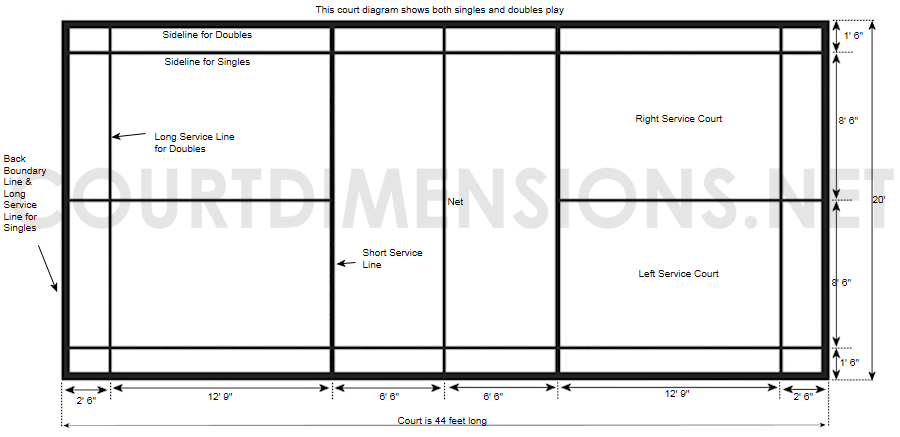Badminton Court Dimensions
Badminton Court Dimensions & Measurements
Most American families love to play badminton as a outdoor backyard sport. Badminton sets are typically inexpensive and can bring hours of family fun. But for the serious competitors, they got to know where the out of bounds lines are. Here you can find out the different dimensions of badminton courts.
Quick Facts About Badminton Court Measurements
How far should the net be off the ground?
The top of the net should be 5 feet, 1 inch at the poles with the center net being one inch less (five feet off the ground).
How wide is a badminton court?
17 feet if you are playing singles; 20 feet for doubles
How long is a badminton court?
22 feet on both sides of the net.
What is that thing called that you hit with the racket in badminton?
Officially it is called a shuttlecock. It has also known as a birdie.
A Closer Look at the Game of Badminton
While it may seem like a relatively modern recreation, the game of badminton has origins stretching back centuries. The modern version familiar to millions today evolved from ancient folk games involving hand-struck projectiles in many cultures across Europe and Asia.
Badminton as we know it took shape in the mid-19th century when British military officers stationed in India added a net to the traditional English children’s game called “battledore and shuttlecock.” In this early ancestor, two players simply hit a small feathered cork object back and forth without any boundaries or scoring.
The officers loved the fast-paced competitive aspect of hitting the “shuttlecock” over a raised net on an impromptu court. They later developed a set of rules inspired by the Indian game “poona,” lending the nascent sport its original name. Replacing the wood “battledore” racquet with a lighter strung design also improved gameplay.
Retired officers brought badminton back to England in the 1870s. The first badminton club formed in the garrison town of Folkestone in 1877. Within 20 years, standardized equipment, court dimensions, and competition rules were established and published by the Badminton Association of England in 1893. This fueled the sport’s growth, with the prestigious All England Open tournament launching in 1899.
Early badminton courts retained aspects of its origins, with a much smaller playing area than today’s standards. Courts were only 16 feet wide, compared to the modern standard of 20 feet for singles and 17 feet for doubles. Nets were also lower at just 4.5 feet off the ground versus today’s 5 foot height.
Badminton’s global popularity exploded in the 20th century. Export of the English game to British colonies like Malaysia, Singapore, India and others sparked intense enthusiasm and growth. Nine national associations founded the International Badminton Federation (now Badminton World Federation) in 1934 to govern international competition and standardize rules worldwide.
The sport made its Olympic debut as an exhibition event at the 1972 Munich Games before gaining full medal status at the 1992 Barcelona Olympics. Top tournament circuits like the Thomas Cup, Uber Cup, and BWF World Championships now showcase incredible athleticism, power, and precision from the world’s best shuttlers.
While starting more casually with wool balls, feather shuttlecocks quickly became standard for achieving the optimal high-speed aerodynamics that define modern badminton’s extremely quick back-and-forth exchanges. Lightweight racquet designs made of advanced composite materials also evolved to provide the ideal blend of power, control, and maneuverability.
Today, badminton boasts over 200 million players in locations ranging from suburban backyards to elite sporting venues. Its combination of fast-paced action yet simple equipment makes it one of the most easily accessible and inexpensive sports to play at any age or skill level. With its roots in ancient folk traditions yet modern global prominence, badminton stands as a unique hybrid of past and present in the athletic world.

